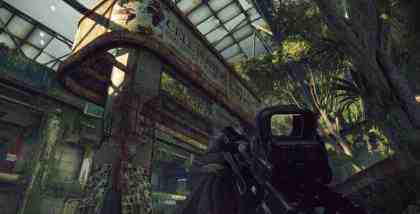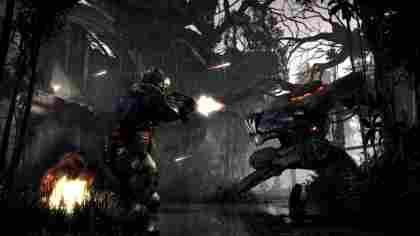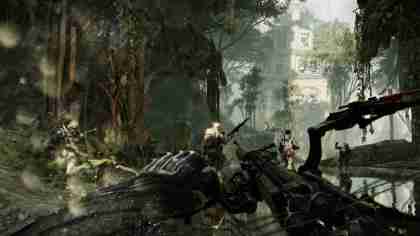If you’re a glutton for punishment and love games that push your PC to the absolute limit, you should be familiar with the Crysis series – created as a pseudo-sequel to Far Cry, the graphically stunning original was all but unplayable on anything but cutting-edge hardware when it launched in 2007. Crysis 3 continues that legacy, with an even more detailed game engine that will put your computer through its paces – just keep in mind that gameplay hasn’t progressed to the same degree.

The switch from PC development to a multi-format release meant Crysis 2 ’s urban environments felt far more constrained than the tropical island original, it was still one of the best-looking shooters around and one we still use to benchmark graphics cards. Crysis 3 retains the ultra-high resolution textures, realistic lighting and impressively realistic water effects, but opens up the game world with sprawling outdoor environments that bring the series back to its roots.
Set within the ruins of a near-future New York, sealed inside a giant dome following the events of the previous game, nature has begun to reclaim the land - waist-high grass has pushed up through blistered asphalt, burst pipes and blocked drains have created marshland, and buildings have crumbled as tree roots twist through their foundations and climb upwards. It’s startlingly beautiful at times, as leaves blow in the wind, water ripples convincingly and the sun creates blinding rays as you pass through wrecked buildings. You’ll need a current-generation graphics card to see the game at its best, although it scales well with older hardware – drop the details to medium and it still looks better than many of its peers.

Once you get past the stunning vistas and lifelike scenery, however, Crysis 3 begins to show its true colours. The plot is difficult to follow at the best of times, putting the player in control of Prophet, the special forces solider who led the Nanosuit solders in the original and who died in the second game. Apparently, the alien technology used to build the Nanosuits let his consciousness live on inside it – good job too, as he’s now humanity’s only hope at stopping the squid-like Seph invasion.
You also have a vendetta against CELL, the private army that has turned New York into a series of oversized bubbles. They are using Seph technology to generate power and hold an energy-starved world to ransom, and will stop and nothing to prevent you from getting to the source – including ripping the Nanosuits from your squad mates. It’s Jason Statham look-a-like Psycho that’s most aggrieved by this, spitting out gruff one-liners like an embittered London taxi driver as you escort him through the early missions. The characters might look more lifelike than ever, but the script doesn’t exactly deviate from the same tired stereotypes.

Gameplay remains fairly unchanged too, although the Nanosuit still gives you the freedom to approach each new level in stealthy silence or with an all-guns-blazing frontal assault. We powered through Crysis 2 with Armour mode almost permanently engaged as there was never an effective way to stay cloaked when picking off enemies – something developer Crytek has addressed for the sequel. Prophet can now use a composite bow, which is fired silently without draining your suit’s cloak energy. Different arrow heads let you electrocute enemies and cause explosions, and although ammo is limited, you can retrieve your arrows from fallen foes.
It’s with the bow that Crysis 3 shines brightest – each new area becomes a puzzle, letting you work out the best way to pick off patrolling CELL troopers without being spotted or setting off the alarms. Inching forward yet staying undetected is immensely satisfying, and arguably more fun than outright gunfights. The Seph aliens are rarely tackled using the same tactics, but present their own unique gameplay opportunities – Prophet is now able to use their weapons against them, turning the tables with monstrously powerful plasma rifles and snipers that fire lightning bolts of explosive energy.

Ultimately though, the game is still mainly a linear experience. Apart from the occasional side mission, which usually requires a slight detour to unlock a weapon cache, or help out some friendly AI soldiers, there’s only one route through each level. The explosive set-pieces often remove control from the player, and only a few of the biggest battles stuck out in our minds once we’d finished the game. It will take the average player around six hours to complete the campaign, without stopping to collect the datapad and dog tag pickups, which is rather brief.
Of course there’s a multiplayer component to keep gamers happy once they’re done with the storyline, with several new game modes designed to take advantage of the new silent arsenal. Hunter is the highlight, putting two players in Nanosuits against up to 14 CELL soldiers with traditional weapons. Armed with bows and permanently invisible, the hunters have to take down the enemy team within the time limit. The twist? Once you die, you join the hunters until there’s only one CELL soldier remaining. Whoever stays alive the longest wins the game.
If you’ve got the PC to run it at the highest quality settings, Crysis 3 is easily one of the best-looking games around. However, we’re judging it as a game, not a benchmark, and this third game doesn’t feel as though it has progressed much from the last instalment. The levels might be larger, but still don’t feel as open as the original, and a few new enemies and weapons do little to shake up the tried and tested formula. Yes, the campaign is filled with explosive set-pieces and looks phenomenal, but it’s over too quickly. We can’t help but feel Ubisoft has taken the Far Cry series in a better direction with Far Cry 3 , while the original developers are happy providing style over substance.
Details | |
|---|---|
| Price | £30 |
| Details | www.ea.com |
| Rating | **** |
